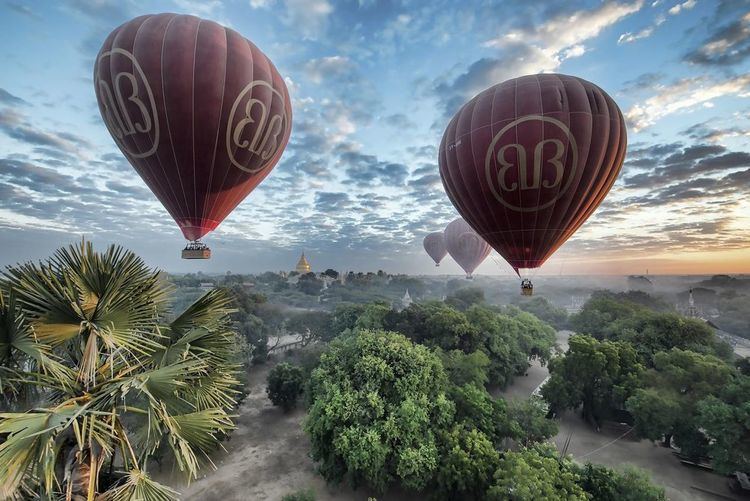 | ||
Tourism in Myanmar (also known as Burma) is a slowly developing sector. Although Burma possesses great tourist potential and attractions in many fields, much of the industry remains to be developed. Also, the number of visitors to Burma is small compared to her neighbours - even outpaced by Laos. This is primarily due to its current political situation. However, after the junta transferred power to the civilian government, the tourism sector saw an increase in tourism arrivals and in 2012, tourist arrivals surpassed the one million mark for the first time. In 2013, the Tourism Master Plan was created, targeting 7.5 million arrivals by 2020.
Contents
- Statistics
- General trends
- Tourists by nationality
- Tourist attractions
- Kachin State
- Yangon
- Mandalay
- Mon State
- Rakhine State
- Shan State
- Other beaches
- Ecotourism
- Politics
- References
Tourism in Burma has been developed mainly by the government, but many private enterprises do exist, catering to a wide range of tourists.
Since 1992, the government has encouraged tourism in the country.
Tourism has been promoted by advocacy groups as a method of providing economic benefit to Burmese civilians, and to avoid isolating the country from the rest of the world. Voices for Burma, a pro-democracy advocate group, states, "We believe that small-scale, responsible tourism can create more benefits than harm. So long as tourists are fully aware of the situation and take steps to maximise their positive impact and minimise the negatives, we feel their visit can be beneficial overall. Responsible tourists can help Burma primarily by bringing money to local communities and small businesses, and by raising awareness of the situation worldwide."
Regardless, a majority of advocacy groups discourage tourism. The junta's forced labour programmes were focused around tourist destinations which have been heavily criticised for their human rights records. A former Burmese tourism minister estimated that 12% of the government revenues are derived from tourism, with the tourism industry contributing $182 million USD (2007) to the government's annual budget.
Statistics
In the 2010-2011 fiscal year, tourists comprised 73.84% (313,127 arrivals) of overseas visitors, primarily entering the country by air, representing 69.26% of arrivals, followed by land and sea, which represented 29.97% and 0.77% of arrivals respectively. An additional 110,914 visitors arrived through other visa types AND represented an additional 26.16% of the total. In 2012, revenues from tourism jumped to over $534 million in 2012, up from $315 million in 2011.
General trends
Tourist arrivals to Yangon Entry Point, Mandalay & Bagan Gateways, Nay Pyi Taw Gateway and Border Tourism.
Tourists by nationality
The governmental statistics body, the Central Statistical Organization, reported more than 3,000,000 travellers flocked to Myanmar in 2014, compared with approximately 816,000 visitors in 2011. Among these, 1,022,081 tourist arrivals (excluding visitors under special entry visas such as social or business visas) were via Yangon International Airport.
Tourist attractions
The most popular available tourist destinations in Burma include big cities such as Yangon and Mandalay; religious sites in Mon State, Pindaya, Bago and Hpa-An; nature trails in Inle Lake, Kengtung, Putao, Pyin Oo Lwin; ancient cities such as Bagan and Mrauk-U; as well as beaches in Nabule Ngapali, Maungmagan Ngwe-Saung, Mergui.
Kachin State
Yangon
Mandalay
Mon State
Rakhine State
Shan State
Other beaches
Ecotourism
Politics
Burma's pro-democracy leader, Aung San Suu Kyi has, in the past, asked for tourism to be boycotted. However, she has not asserted this view recently. This might be due to public opinion being in favour of tourism. The majority of democracy advocates demand a complete boycott of tourism to Burma. Other pro-democracy activists, such as Ma Thanegi, advocate small scale tourism, and careful spending.
In May 2011, however, Aung San Suu Kyi and her party National League for Democracy expressed the opinion that responsible tourism to Burma should be encouraged. Tourists are welcome to Burma provided they are "keen to promote the welfare of the common people and the conservation of the environment and to acquire an insight into the cultural, political and social life of the country while enjoying a happy and fulfilling holiday in Burma." In their official statement they request not only the development of the people's livelihood but also the promotion of "self respect and self reliance in the people."
Certain tour books, such as Lonely Planet, cover Burma, stating that it provides balanced information and spending methods to get the money into the hands of the people, while some, such as Rough Guides, refuse to publish on Burma. Most Ministries of Foreign Affairs in the Western world recommend travel agencies and citizens not to engage in tourism activities in Burma.
Research conducted in 2012 cautions against the assumption that more foreign tourism, even in the framework of the government's "Responsible Tourism Policy," would automatically support the people of Burma and lead to a Trickle-down effect. Rather, it concludes, tourism would most likely benefit crony businesses and further entrench human rights violations.
